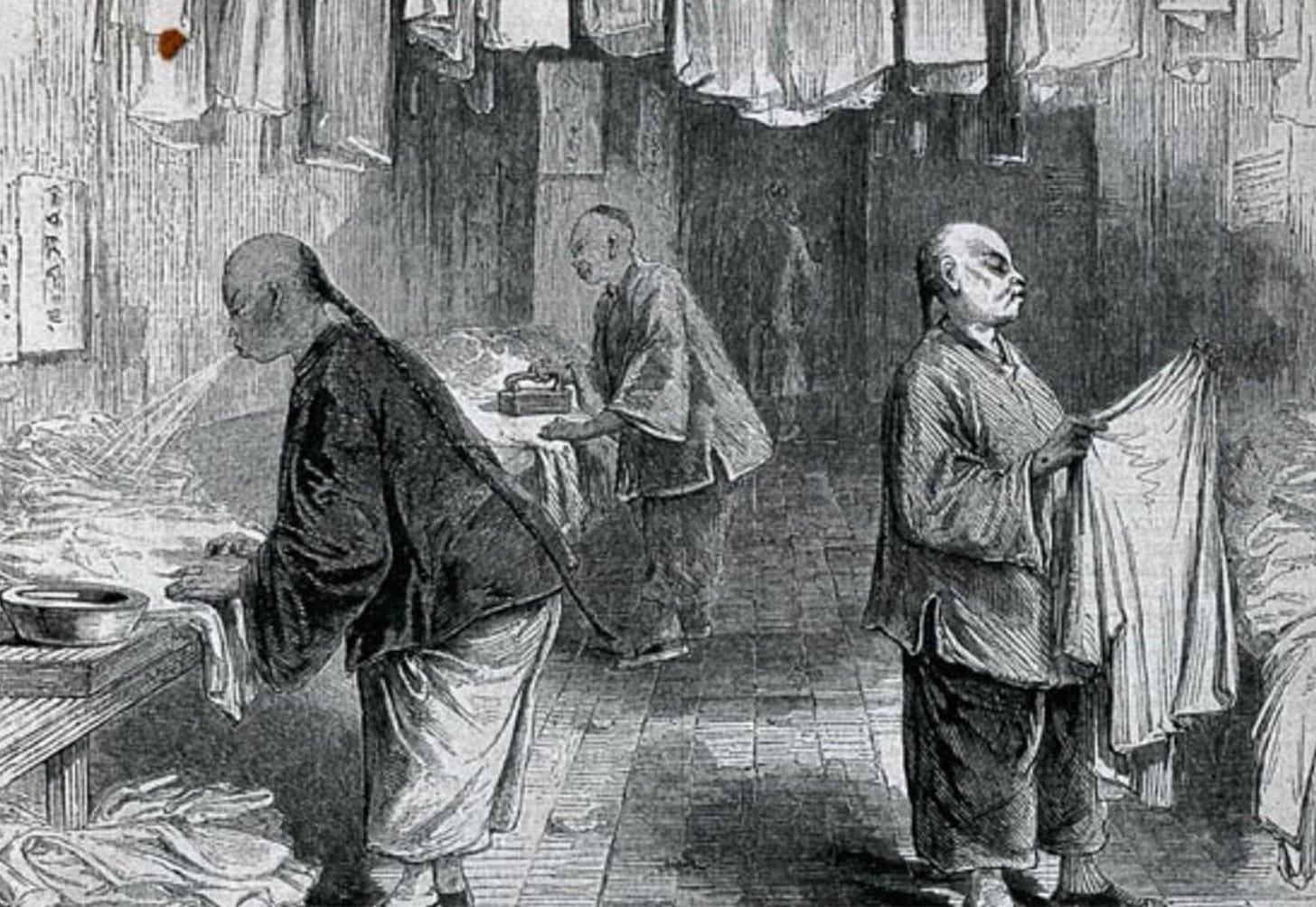More Off-White Washing History and “White-Adjacency”: How The Lens Of Intersectionality Degrades Anti-Asian Racism
History, Rinse, & Repeat has previously addressed the efforts by so-called anti-racism advocates to ignore, if not eradicate, the history of anti-Asian racism by the invention of the term “White-Adjacent.” Drawing upon John Dower’s history of the Pacific War, War Without Mercy, this site sought to demonstrate that the history of this country’s treatment of Asians, and the Japanese more particularly, belies any suggestion that Asians are the beneficiaries of some sort of historical privilege. This site further sought to show that many of the tactics of the progressive left mirror those practiced by White supremacists of the last century.
While our prior piece focused on the attitude of Whites with respect to the Japanese in this country, before, during, and after World War II, of equal relevance to where Asians have historically fit in the so-called matrix of intersectionality is the attitude of Blacks toward Asians. That attitude has shifted depending upon the circumstances of the time. Such shifts shed their own light on the concept of “White-Adjacency.”
Pre-World War II
It is hardly surprising the relations between Blacks and Asians, particularly Chinese immigrants were, from the outset, fraught with conflict. There were a number of reasons for this, but the primary reason was economic – early Chinese immigrants competed with Blacks for the same jobs. In California, Chinese workers particularly competed with Blacks for positions as household domestics and launderers. In Denver, Colorado, a number of hotels fired their Black wait staff and replaced them with Chinese waiters. On several occasions, the Pullman Company employed Chinese porters to prevent Blacks from unionizing.
The complaint from Blacks with respect to Asian competitors was the same as that from poor White laborers. As one Black newspaper, the Washington Colored American wrote, no one who wanted an “attractive home and who insisted upon ample food for his family” was able to work for the starvation wages of the Chinese.
The demand for cheap Asian labor was not limited to the West coast. In the early twentieth century, Southern farmers sought to import Chinese laborers to work in the fields. They quickly discovered that such laborers, unfamiliar with cotton farming and the machinery utilized in connection therewith, were not nearly as efficient as Black laborers whose families had engaged in such farming for generations.
However, Blacks’ conflict with Asians was not purely economic. There existed a cultural element as well. Part of this was due to the initially distinctly different appearance of Chinese immigrants. Another part was due to language. Another part was due to religion – Blacks were, like their White compatriots, predominantly Christian. Professor Arnold Shankman of Winthrop University, writing in the journal Phylon, summarized the view of many Blacks:
“Like most whites, Negroes found the Chinese to be a peculiar and superstitious people who were ‘filthy, immoral and licentious – according to our notions of things.’ Particularly repulsive was their ‘grotesque appearance.’ The ‘wretched looking’ Orientals shaved their heads with “the exception of the top of the hair from which is formed a plaited tail, resembling ‘pig tail tobacco.’ Furthermore, a black complained, a Chinaman’s ‘vacant Know Nothing face is expressive of nothing but stupidity.’”
Booker T. Washington, after visiting a Chinese community in Arizona commented that “the thing that most impressed me in regard to the Chinaman was the extent to which he is an alien in this country. I doubt whether any other portion of the population remains so thoroly [sic] foreign as is true of the Chinaman.” As noted in our prior piece, this sentiment would be reflected in American attitudes toward the Japanese in World War II.
Notwithstanding the majority view of the Chinese, some Black commentators opposed laws that prescribed Chinese immigration to this country. Their view was not informed by any solidarity with Asians, but by the practical view that discrimination against one minority could easily be directed at another. As one Black newspaper editorialized: “The party that endorses the unjust laws against the Chinese will not be just to the colored man or anyone else, except when it is convenient.”
It is apparent that, at least in the initial stages of Asian immigration into this country, there was no basis to categorize Asians as “White-Adjacent.” The view of Blacks was not that Asians shared the privileges of Whites, but that, if anything, Asians were beneath them. Chinese immigrants coexisted near the apex of the matrix of intersectionality. The odd juxtaposition of Blacks and Asians was recognized by Justice Harlan’s dissent in the famous case, Plessy v. Ferguson, in which the Supreme Court upheld, pursuant to the doctrine of “separate but equal,” laws in Louisiana that segregated rail cars on the basis of race. In his dissent, Harlan expressed amazement that Chinese, who were not allowed to vote, were permitted by the statute to ride in cars designated White, while Blacks were not.
“There is a race so different from our own that we do not permit those belonging to it to become citizens of the United States. Persons belonging to it are, with few exceptions, absolutely excluded from our country. I allude to the Chinese race. But, by the statute in question, a Chinaman can ride in the same passenger coach with white citizens of the United States, while citizens of the black race in Louisiana, many of whom, perhaps, risked their lives for the preservation of the Union, who are entitled, by law, to participate in the political control of the state and nation, who are not excluded, by law or by reason of their race, from public stations of any kind, and who have all the legal rights that belong to white citizens, are yet declared to be criminals, liable to imprisonment, if they ride in a public coach occupied by citizens of the white race.”
Plessy v. Ferguson would, in the coming years, be utilized against Chinese children. In the 1927 case, Gong Lum v. Rice, the Supreme Court affirmed the enforcement of a Mississippi statute that barred a Chinese girl from attending a White school and, instead, required her to attend a “colored school.”
World War II
As described in a previous post on this site, the pre-existing prejudice against Asians or, more specifically, against Japanese immigrants, was exacerbated by the hostilities between the United States and Japan, particularly after the attack on Pearl Harbor. The racial elements of the war between the United States and Japan were not unintended consequences. From the very outset, the Japanese framed their war in racial terms. This was explicitly the lesson taught by a book given to every Japanese officer and enlisted man embarking for combat at the outset of the war, Read This and the War Is Won.
The book described how most of the Far East was governed by White colonialists. Half a million British ruled 350 million Indians; tens of thousands more ruled 6 million Malayans. Two hundred thousand Dutchman ruled the East Indies, twenty thousand Frenchman controlled 23 million Indo-Chinese, and a few tens of thousands Americans ruled over 13 million Filipinos. Tallied up, eight hundred thousand Whites controlled 450 million Asians. The book explained that White men were arrogant colonials, who viewed it as their birthright to have colonial servants. “Money squeezed from the blood of Asians maintains these small white minorities in their luxurious mode of life – or disappears to the respective home countries.” The book instructed the Japanese soldier that the war was “a struggle between races,” and that the Japanese objective was to “liberate East Asia from white invasion and oppression.”
Given the Japanese perception that the war was a struggle between races, it is hardly surprising that Japanese propagandists attempted to influence Black opinion in the United States. A Japanese agent established contact with Elijah Muhammad and the Black Muslim movement. In fact, Muhammed and leaders of other militant Black groups were arrested for allegedly seditious activities, including voicing support for a Japanese victory.
However, Japanese influence on changing Black attitudes toward Asians was due less to their propaganda than to their achievements at the beginning of the war. For many Black militants, the early successes of the Japanese destroyed the myth of White omnipotence. As Roy Wilkins, later head of the NAACP, is reported to have remarked, Pearl Harbor was due at least in part to Whites’ habit of looking down on non-Whites. An article in Atlantic Monthly openly expressed the fears of many American leaders:
“Like the natives of Malaya and Burma, the American Negroes are sometimes imbued with the notion that a victory for the yellow race over the white race might be a victory for them.”
Other Black leaders expressed solidarity with victims of White colonialism, including A. Philip Randolph, who created and led the Pullman workers union, and who called for a “global union of the darker races.” Walter White, the head of the NAACP, also foresaw such a union in his book, A Rising Wind:
“World War II has given the Negro a sense of kinship with other colored -- and also oppressed – peoples of the world. Where he has not thought through or informed himself on the racial angles of colonial policy and master-race theories, he senses that the struggle of the Negro in the United States is part and parcel of the struggle against imperialism and exploitation in India, China, Burma, Africa, the Philippines, and South America. The Negro soldier is convinced that as time proceeds that identification of interest will spread even among some brown and yellow peoples who today refuse to see the connection between their exploitation by white nations and discrimination against the Negro in the United States.”
Thus, by the end of the war, the attitude of Blacks toward Asians appears to have changed significantly. However, this change was double-edged. Although it was more favorable toward Asians, it was based, not on any assessment of Asians in and of themselves, but upon their relation to Whites.
Post War Years
The union predicted by Randolph and White, at least between Asians and Blacks, did not come to pass. Anti-colonialism continued apace, and the perception of Asians by the White majority in this country was turned on its head. Indeed, Daniel Patrick Moynihan, while researching his 1965 landmark study, The Negro Family: The Case For National Action, presaged the concept of “White-Adjacency” by noting the “astonishing” gains made by Asians in their fight against racism, asking: ““Am I wrong that they have ceased to be colored?”
Instead of union, the rift returned between Blacks and Asians. That rift (at least with respect to Koreans) was portrayed in the Spike Lee movie, Do the Right Thing, and was laid bare to the nation in the Los Angeles riots following the beating of Rodney King.
This rift has crystallized into the concept “White-Adjacency,” a term that literally measures Asians not on their own merits, but by their relationship to Whites. One might argue that such an assessment, which measures Asians not by any endemic, identifiable characteristic, but rather as simply a proxy for Whites, is as racist as Blacks’ assessment more than a century ago.





